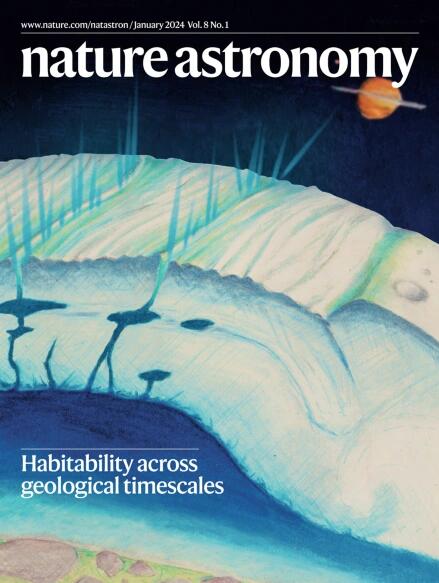旅行者 2 号观测到天王星磁层处于罕见的压缩状态
IF 12.9
1区 物理与天体物理
Q1 ASTRONOMY & ASTROPHYSICS
引用次数: 0
摘要
1986 年旅行者 2 号的发现使人们得出结论,天王星拥有太阳系内最极端的磁层。对这一数据集的重新分析表明,旅行者 2 号的极端观测结果可能是由异常强烈的上游太阳风条件造成的。本文章由计算机程序翻译,如有差异,请以英文原文为准。

Voyager 2 observed Uranus’s magnetosphere in a rare, compressed state
Discoveries made by Voyager 2 in 1986 led to the conclusion that Uranus possesses the most extreme magnetosphere within the Solar System. Reanalysis of this dataset suggests that the extreme observations made by Voyager 2 could have been caused by anomalously intense upstream solar wind conditions.
求助全文
通过发布文献求助,成功后即可免费获取论文全文。
去求助
来源期刊

Nature Astronomy
Physics and Astronomy-Astronomy and Astrophysics
CiteScore
19.50
自引率
2.80%
发文量
252
期刊介绍:
Nature Astronomy, the oldest science, has played a significant role in the history of Nature. Throughout the years, pioneering discoveries such as the first quasar, exoplanet, and understanding of spiral nebulae have been reported in the journal. With the introduction of Nature Astronomy, the field now receives expanded coverage, welcoming research in astronomy, astrophysics, and planetary science. The primary objective is to encourage closer collaboration among researchers in these related areas.
Similar to other journals under the Nature brand, Nature Astronomy boasts a devoted team of professional editors, ensuring fairness and rigorous peer-review processes. The journal maintains high standards in copy-editing and production, ensuring timely publication and editorial independence.
In addition to original research, Nature Astronomy publishes a wide range of content, including Comments, Reviews, News and Views, Features, and Correspondence. This diverse collection covers various disciplines within astronomy and includes contributions from a diverse range of voices.
 求助内容:
求助内容: 应助结果提醒方式:
应助结果提醒方式:


